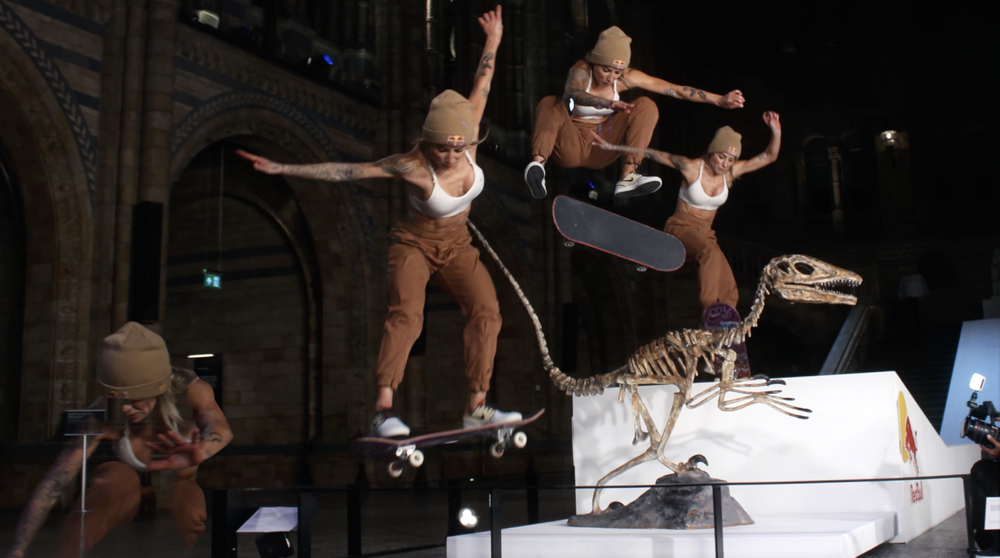Six tips for working with athletes
Over the years, we’ve built a packed portfolio of athlete collaborations for global brands, working with big names like Max Verstappen, Lewis Hamilton, the Real Madrid team, Geraint Thomas, Marianne Vos, Leticia Bufoni, Ken Block, Cristina Gutierrez, Valentino Rossi, Danny Macaskill, Wout van Aert—the list goes on.
Working with the world's best performers, the biggest names, and the most in-demand athletes out there, it’s fair to say we know a thing or two about maximising athlete collaborations for our clients.
Athletes are built different
They take a unique approach to their craft, honing their skills and passion for years to consistently deliver peak performance. It’s what makes them so fascinating to watch.
It might seem like obvious stuff, but for us as creators and brands leveraging partnerships, it’s pretty significant. Activating an athlete isn’t like working with any other 'talent', celebrity, or influencer; they bring a unique physicality to their roles, so from the get-go, the creative must allow the athlete to shine and connect authentically with their audience.
Whether developing a campaign, capturing a creative performance, filming dialogue, or storytelling, you've got to bring out the best in your partnership and create athlete content that truly resonates.
With the Olympics around the corner, brands are starting to leverage their athlete partnerships. Too often, we see content that falls flat, missing the mark in performance, personality, or authenticity, whether it's with a track and field athlete, a skateboarder, or a track cyclist.
So, in the spirit of sharing, here are some lessons we've learned from working with world-class athletes over the years.
1) Personality is priceless
Fans don’t just follow athletes for their skills. Sure, being the best in the world helps, but fandom goes deeper. People get invested in the athlete's character, persona, and journey.
A creative approach and crew that can bring out an athlete’s personality on camera will keep your audience engaged and craving more—while you reap the rewards organically.
It’s a win-win.
We were so lucky to get to collaborate with the late Ken Block, creating a project with him and his daughter Lia. It was a special one.
2) They know better than you
No matter how much you think you know, the athlete always knows more about their sport than you.
Get them involved early and often. The possibility of this varies depending on the athlete and access, but their input in the early stages can be invaluable.
Whether in the planning stages or simply reviewing shots, their unique perspective is gold. Not only will they respect it, but they’ll also become way more invested in helping you achieve your goals.
Take Danny MacAskill, for example. We’ve been creating internet-breaking content together for years, racking up hundreds of millions of views. Yet, at media events or with other agencies/production companies creating different content on-set, it’s blown our minds the number of times we’ve seen people directing Danny to do things that were just unreasonable. ‘Backflip off this’, ‘jump off that’, asking him to do ridiculous stunts or tricks from a place of zero knowledge.
Instead, talk to the athlete about your goals in advance, and they'll give you great ideas in return.
3) Time is money; planning makes perfect
When working with those big-name stars, you usually have very little time to film—and it's on you to get the most out of a tiny and often spontaneous window. It could be just six minutes with the Real Madrid captain or 15 minutes with an F1 world champ.
As Eminem so succinctly put it, "You have one shot, one opportunity." 🍝
This is where your agency and production team really earn their money. Brands can invest millions in athlete partnerships, so those few minutes of access could be some of the year’s most important moments.
You better damn well make sure you know exactly what you want from that time and have a team that will capture it and work with the athlete in the best possible way. In other words, don't let it slip.
For each project, we meticulously plan and plan some more. This involves not just creating a shot list and questions but also creating test footage to make sure we're clear on the shots and have already pieced them together in the edit. Researching the athlete, leveraging relationships, and giving clear examples of what we need are all part of our prep.
An experienced crew and thorough planning are essential for getting results.
4) If they love the idea, so will the fans
Press conferences, interviews, TV appearances, you name it—athletes deal with plenty of uninspiring moments in front of a camera. Being just another bland filming opportunity on their schedule isn't going to do anyone any favours. You could have a quick four-minute burst on a busy media day or master never-before-seen tricks at different spots over four months; getting their buy-in from the start is crucial.
This is your opportunity to get creative.
Seeing Wout van Aert's face light up when he walked into our dramatic chess tournament setup and realised he didn't have to ride his bike or deliver scripted lines to the camera—unlike everything else he had to do that day—was priceless.
Whether it’s surprising Max Verstappen with a challenge to chase him around the track with the world's fastest camera drone or giving Rob Warner the keys to a stately home (complete with a dram and a butler), when you pitch a fun, novel concept that fits their vibe, they'll be more than invested in your idea.
Basically, don't make it boring.
When you create something that athletes are genuinely into, their fans will love it, too.
5) Give audiences something they’ve never seen
When you're developing a creative approach, it's all about understanding your audience, the sport, and athletes and then presenting it in a fresh way.
At the end of the day, organic content always wins. If your approach resonates and connects with the audience, it'll keep them engaged and hold their attention, prompting comments and shares. That's the stuff the algorithms love, which means more people will discover your content the way the platform gods intended: in their feeds, recommended videos, and search results.
Show fans their favourite athlete in an authentic way, stir up emotions and give them something new. Your approach needs to deliver on that.
From our experience, there are all kinds of ways to do it; some examples from our work would be capturing F1 in a new way for Red Bull, comparing cycling to chess for Cervelo, or seeing a world-famous UFC fighter playing classical piano.
Authenticity and surprise? That's the winning combo.
6) Sports is a specialist subject
Working with a team that understands the sport’s intricacies will undoubtedly result in the best footage.
From specialist surf cinematographers to capturing rally raids, working with an athlete on their 300th trick attempt for a Red Bull video, or documenting intimate stories, each project is a privilege.
It's the dream job for many filmmakers, but the best results always come from a passionate, specialist crew.
If you’re looking for a skilled sports content crew to maximise your athlete partnership, get in touch 📧














